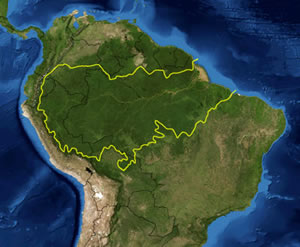Amazon Rainforest
The Amazon-Orinoco rainforest is the largest tropical rainforest region on Earth.
 The Amazon lies mainly within Brazil. At its western flank, Bolivia, Peru, Ecuador and Colombia share the forested headwaters.
The Amazon lies mainly within Brazil. At its western flank, Bolivia, Peru, Ecuador and Colombia share the forested headwaters.
To the north lies the Orinoco basin, which is mostly in Venezuela.
The northeastern part of this forest extends into Guyana, Suriname and French Guiana.
The Amazon River carries a greater volume of water than any river in the world. Every day, during maximum flood, one fifth of all the river water on earth flows into the Atlantic Ocean from the Amazon.
The Amazon is second only to the Nile in length. For its entire length, it is joined by tributaries which are themselves major waterways, some larger than the Mississippi.
The main rivers flood annually. They are flanked by permanent or seasonal swamp forest.
The western part of the Amazon zone experiences hardly any seasonal climatic changes.
The most important world crops of Amazonian origin are para rubber and cocoa. Mahogany and Brazil nuts also come from the Amazon rainforest.
Atlantic Coastal Rainforest.
On the Atlantic coastal range of Brazil lies a another block of rainforest, with a unique variety of plants and animals
Chocó Rainforest
The Chocó rainforest lies on the northwest coast of South America, between the Pacific and the foothills of the Andes in Colombia.
It reaches south as far as northern Ecuador. It runs north through the Isthmus of Panama, up the Caribbean side as far as southern Mexico.
This is one of the wettest places on Earth, with rainfall of over 236 inches (6,000mm) a year. In a few places, rainfall is more than 393 inches (10,000mm) a year.
This rainforest has many plant and animal species that can be found nowhere else in the world.